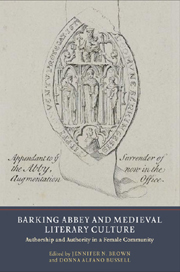Book contents
- Frontmatter
- Contents
- List of Contributors
- Acknowledgements
- List of Abbreviations
- Dedication
- Introduction: Barking's Lives, the Abbey and its Abbesses
- I BARKING ABBEY AND ITS ANGLO-SAXON CONTEXT
- 1 Barking's Monastic School, Late Seventh to Twelfth Century: History, Saint-Making and Literary Culture
- 2 The Saint-Maker and the Saint: Hildelith Creates Ethelburg
- 3 Goscelin of Saint-Bertin and the Translation Ceremony for Saints Ethelburg, Hildelith and Wulfhild
- 4 ‘The ladies have made me quite fat’: Authors and Patrons at Barking Abbey
- II BARKING ABBEY AND ITS ANGLO-NORMAN CONTEXT
- III BARKING ABBEY AND THE LATER MIDDLE AGES
- Afterword. Barking and the Historiography of Female Community
- Bibliography
- Index
- YORK MEDIEVAL PRESS: PUBLICATIONS
1 - Barking's Monastic School, Late Seventh to Twelfth Century: History, Saint-Making and Literary Culture
from I - BARKING ABBEY AND ITS ANGLO-SAXON CONTEXT
Published online by Cambridge University Press: 05 April 2013
- Frontmatter
- Contents
- List of Contributors
- Acknowledgements
- List of Abbreviations
- Dedication
- Introduction: Barking's Lives, the Abbey and its Abbesses
- I BARKING ABBEY AND ITS ANGLO-SAXON CONTEXT
- 1 Barking's Monastic School, Late Seventh to Twelfth Century: History, Saint-Making and Literary Culture
- 2 The Saint-Maker and the Saint: Hildelith Creates Ethelburg
- 3 Goscelin of Saint-Bertin and the Translation Ceremony for Saints Ethelburg, Hildelith and Wulfhild
- 4 ‘The ladies have made me quite fat’: Authors and Patrons at Barking Abbey
- II BARKING ABBEY AND ITS ANGLO-NORMAN CONTEXT
- III BARKING ABBEY AND THE LATER MIDDLE AGES
- Afterword. Barking and the Historiography of Female Community
- Bibliography
- Index
- YORK MEDIEVAL PRESS: PUBLICATIONS
Summary
Of the seven religious houses for women founded in the late ninth and early tenth centuries with varying degrees of support from the Wessex royal family, only Barking was established on the site of an ancient double monastery. It therefore has an unassailable claim to have been ‘the home of the longest lived tradition of female learning and literacy in British history’. Bell suggests that this long tradition of learning and literacy – which he regards as having been inseparably related to an equally long existence as a wealthy and aristocratic institution – explains the composition of Anglo-Norman vitae by Barking nuns in the second half of the twelfth century.
Barking's tradition of learning and literacy was not, of course, an unbroken one. The disruption to monastic life that followed in the wake of the ninth-century Danish invasions is well known. The female community at Barking from the time of its mid-tenth-century refoundation until its dissolution had no tangible connection, other than the ruined buildings it occupied, with the mixed community of monks and nuns who had previously inhabited the site, although the ongoing importance that the later community attached to its early history and the continued spiritual presence of its first two abbesses is evident in the works Goscelin was commissioned to write for Barking c. 1086.
- Type
- Chapter
- Information
- Barking Abbey and Medieval Literary CultureAuthorship and Authority in a Female Community, pp. 33 - 55Publisher: Boydell & BrewerPrint publication year: 2012

